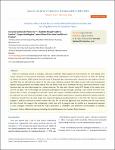Patterns of Diurnal and Nocturnal Cub-Directed Social Interaction and Guarding Behaviour in Sumatran Tigers
| dc.contributor.author | Pastorino, GQ | |
| dc.contributor.author | Dougal, C | |
| dc.contributor.author | Sanders, K | |
| dc.contributor.author | Stubbington, T | |
| dc.contributor.author | Brereton, JE | |
| dc.contributor.author | Preziosi, Richard | |
| dc.date.accessioned | 2023-05-09T13:56:20Z | |
| dc.date.available | 2023-05-09T13:56:20Z | |
| dc.date.issued | 2022-09-01 | |
| dc.identifier.issn | 2582-3183 | |
| dc.identifier.uri | https://pearl.plymouth.ac.uk/handle/10026.1/20867 | |
| dc.description.abstract |
Felids are commonly housed in zoological collections worldwide. While aspects of their behaviour are well studied, there remain questions on best practice husbandry including during reproduction and breeding scenarios. In 2016, the Zoological Society of London’s (ZSL) London Zoo held a pair of Sumatran tigers (Panthera tigris sumatrae) for the purpose of breeding. While they are believed to be solitary in the wild, many collections maintain their tigers in pairs, with some keeping pairs together during parturition and rearing periods. The aim of this study was to investigate the social interactions between a male Sumatran tiger and cubs when housed in a shared enclosure. The data were collected using CCTV footage in the indoor enclosure for the tigers. The CCTV footage ran continuously throughout the day and night, allowing a more holistic overview of behaviour. These 24-hour recordings were split into 6 equal hour ranges to calculate behaviour activity budgets and proximity of the male from the cubs. Data were analysed using a Chi-squared test for association to determine differences between individual behaviour. Overall, the male spent longer than expected engaging in guarding behaviour of the cubs. The male also regularly engaged in affiliative behaviours directed towards the cubs. No cub-directed aggression was observed from the male toward the cubs. Overall, this suggests that maintaining a male tiger with its progeny may be feasible as a management approach in some zoological collections, provided the male’s personality is compatible, and alternative accommodation is available. | |
| dc.format.extent | 70-78 | |
| dc.publisher | Acta Scientific Publications Pvt. Ltd. | |
| dc.title | Patterns of Diurnal and Nocturnal Cub-Directed Social Interaction and Guarding Behaviour in Sumatran Tigers | |
| dc.type | journal-article | |
| plymouth.publication-status | Published online | |
| plymouth.journal | Acta Scientific Veterinary Sciences | |
| dc.identifier.doi | 10.31080/asvs.2022.04.0499 | |
| plymouth.organisational-group | |Plymouth | |
| plymouth.organisational-group | |Plymouth|Faculty of Science and Engineering | |
| plymouth.organisational-group | |Plymouth|Faculty of Science and Engineering|School of Biological and Marine Sciences | |
| plymouth.organisational-group | |Plymouth|REF 2021 Researchers by UoA | |
| plymouth.organisational-group | |Plymouth|Users by role | |
| plymouth.organisational-group | |Plymouth|Users by role|Academics | |
| plymouth.organisational-group | |Plymouth|REF 2021 Researchers by UoA|UoA07 Earth Systems and Environmental Sciences | |
| dcterms.dateAccepted | 2022-08-04 | |
| dc.date.updated | 2023-05-09T13:56:20Z | |
| dc.rights.embargodate | 2023-5-10 | |
| dc.rights.embargoperiod | forever | |
| rioxxterms.versionofrecord | 10.31080/asvs.2022.04.0499 |


